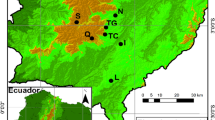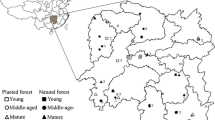Abstract
The accumulation of carbon of organic matter by forest phytocenoses during photosynthesis is their most important function, mitigating climate change on the Earth. The literature provides data that the territory of the Russian Federation is a large sink of atmospheric carbon. However, the estimates of the sink, as well as the values of the net primary production (NPP) of forest ecosystems, vary widely. This paper presents materials describing the net carbon production of phytomass in pine forests of different types of growing conditions in the northern and middle taiga of the Komi Republic. Premature, mature, and old-growth pine forests of green moss, lichen, and sphagnum types have been studied at forest stations. The carbon sequestration by the forest stand is assessed by biological productivity using sample trees. The regression equations for the dependence of the increments of individual organs of a sample tree on the stem diameter at a height of 1.3 m are composed. A statistically significant relationship is found between these parameters, characterized by high trend approximation values varying from 0.44 to 0.99 (at 95% significance level). It is calculated that, under the conditions of the European Russian northeast, the NPP of carbon in pine phytocenoses varies within the range of 1.9–4.5 t C ha–1 year–1. It is established that the tree stand accounts for 32–73% of the total NPP. With increasing soil moisture and moving northward, the participation of plants in the ground vegetation increases in the total NPP. It is noted that a significant part of the NPP of carbon of the tree layer of pine forests is formed by the photosynthetic apparatus and the stem wood. Based on these data, the conversion relations between NPP and wood volume/carbon stock in the stand for pine forests of the northern and middle taiga are derived.


Similar content being viewed by others
REFERENCES
Andreeva, E.N., Bakkal, I.Yu., gorshkov, V.V., Lyanguzova, I.V., Maznaya, E.A., Neshataev, V.Yu., Stavrova, N.I., Yarmishko, V.T., and Yarmishko, M.A., Metody izucheniya lesnykh soobrahshchestv (Study Methods of Forest Communities), St. Petersburg: Nauchno-Issled. Inst. Khim., S.-Peterb. Gos. Univ., 2002.
Bhatti, J.S. and Jassal, R.S., Long term aboveground litterfall production in boreal jack pine (Pinus banksiana) and black spruce (Picea mariana) stands along the Boreal Forest Transect Case Study in western central Canada, Écoscience, 2014, vol. 21, nos. 3–4, pp. 301–314.
Bobkova, K.S., Biologicheskaya produktivnost’ khvoinykh lesov evropeiskogo Severo-Vostoka (Biological Productivity of Coniferous Forests of European Northeast), Leningrad: Nauka, 1987.
Bobkova, K.S., Biological productivity and the components of carbon balance in young pine forests, Lesovedenie, 2005, no. 6, pp. 30–37.
Bobkova, K.S. and Osipov, A.F., Carbon cycle in the phytocenosis–soil system of blueberry-sphagnum pine forests of middle taiga of the Komi Republic, Lesovedenie, 2012, no. 2, pp. 11–18.
Ekologo-fiziologicheskie osnovy produktivnosti sosnovykh lesov evropeiskogo Severo-Vostoka (Ecological and Physiological Principles of Productivity of Pine Forests of European Northeast), Bobkova, K.S., Ed., Syktyvkar: Komi Nauchn. Tsentr, Ural. Otd., Ross. Akad. Nauk, 1993.
FAO, 2015. http://www.fao.org/3/a-az316e.pdf. Accessed May 14, 2019.
Galenko, E.P., Fitoklimat i energeticheskie factory produktivnosti khvoinogo lesa Evropeiskogo Severa (Phytoclimate and Energetic Productivity Factors of a Coniferous Forest of European North), Leningrad: Nauka, 1983.
Hardiman, B.S., Gough, C.M., Halperin, A., Hofmeister, K.L., Nave, L.E., Bohrer, G., and Curtis, P.S., Maintaining high rates of carbon storage in old forests: a mechanism linking canopy structure to forest function, For. Ecol. Manage., 2013, vol. 298, pp. 111–119.
Isaev, A.S. and Korovin, G.N., Forests as a national treasure of Russia, Contemp. Probl. Ecol., 2013, vol. 6, no. 7, pp. 677–682.
Isaev, A.S., Korovin, G.N., Utkin, A.I., Pryazhnikov, A.A., and Zamolodchikov, D.G., Assessment of reserves and annual deposition of carbon in phytomass of forest ecosystems of Russia, Lesovedenie, 1993, no. 5, pp. 3–10.
Isaev, A., Korovin, G., Zamolodchikov, D., Utkin, A., and Pryaznikov, A., Carbon stock and deposition in phytomass of the Russian forests, Water, Air Soil Pollut., 1995, vol. 82, pp. 247–256,
Isaev, A.S., Ovchinnikova, T.M., and Sukhovol’skii, V.G., Distribution of tree and plantation phytomass by fractions: model of competition, Probl. Ekol. Monit. Model. Ekosist., 2007, vol. 21, pp. 232–250.
Isaev, A.S., Bartalev, S.A., Lupyan, E.A., and Lukina, N.V., Earth observations from satellites as a unique instrument to monitor Russia’s forests, Herald Russ. Acad. Sci., 2014, vol. 84, no. 6, pp. 413–419.
Kazimirov, N.I., Volkov, A.D., Zyabchenko, S.S., Ivanchikov, A.A., and Morozova, R.M., Obmen veshchestv i energii v sosnovykh lesakh Evropeiskogo Severa (Exchange of Substances and Energy in Pine Forests of European North), Leningrad: Nauka, 1977.
Keeling, H.C. and Phillips, O.L., The global relationship between forest productivity and biomass, Global Ecol. Biogeogr., 2007, vol. 16, no. 5, pp. 618–631.
Kutyavin, I.N., Sosnovye lesa severnogo Priural’ya: stroenie, rost, produktivnost’ (Pine Forests of Northern Cis-Ural Region: The Structure, Growth, and Productivity), Syktyvkar: Inst. Biol., Komi Nauchn. Tsentr, Ural. Otd., Ross. Akad. Nauk, 2018.
Kutyavin, I.N., Torlopova, N.V., Osipov, A.F., Kuz’mina, E.S., and Bobkova, K.S., Biological productivity of indigenous lingonberry-lichen middle taiga pine forest (middle Pechora River), Rastit. Resur., 2016, no. 4, pp. 484–500.
Kuznetsov, M.A., Content dynamics of organic carbon in wetland spruce forests of middle taiga, Extended Abstract of Cand. Sci. (Biol.) Dissertation, Syktyvkar: Inst. Biol., Komi Sci. Center, Ural Branch, Russ. Acad. Sci., 2010.
Lukina, N.V., Isaev, A.S., Kryshen’, A.M., Onuchin, A.A., Sirin, A.A., Gagarin, Yu.N., and Bartalev, S.A., Priority trends in the development of forest science as the basis for sustainable forest management, Lesovedenie, 2015, no. 4, pp. 243‒254.
Luo, Y., Keenan, T.F., and Smith, M., Predictability of the terrestrial carbon cycle, Global Change Biol., 2015, vol. 21, no. 5, pp. 1737–1751.
Luyssaert, S., Schulze, E.-D., Börner, A., Knohl, A., Hessenmöller, D., Law, B.E., Ciais, P., and Grace, J., Old-growth forests as global carbon sinks, Nature, 2008, vol. 455, pp. 213–215.
Metsaranta, J.M., Trofymow, J.A., Black, T.A., and Jassal, R.S., Long-term time series of annual ecosystem production (1985–2010) derived from tree rings in Douglas-fir stands on Vancouver Island, Canada using a hybrid biometric-modeling approach, For. Ecol. Manage., 2018, vol. 429, pp. 57–68.
Nikonov, V.V., Pochvoobrazovanie na severnom predele sosnovykh bogeotsenozov (Pedogenesis in the North Margin of Pine Biogeocenosises), Leningrad: Nauka, 1987.
Nilsson, M.-C. and Wardle, D.A., Understory vegetation as a forest ecosystem driver: evidence from the northern Swedish boreal forest, Front. Ecol. Environ., 2005, vol. 3, no. 8, pp. 421–428.
Osipov, A.F. and Bobkova, K.S., Biological productivity and carbon fixation in middle taiga pine forests during the transition from middle-aged to ripe, Lesovedenie, 2016, no. 5, pp. 346–354.
Phua, M.-H., Johari, S.A., Wong, O.C., Ioki, K., Mahali, M., Nilus, R., Coomes, D.A., Maycock, C.R., and Hashim, M., Synergistic use of Landsat 8 OLI image and airborne LiDAR data for above-ground biomass estimation in tropical lowland rainforests, For. Ecol. Manage., 2017, vol. 406, pp. 163–171.
Schaphoff, S., Reyer, C.P.O., Schepaschenko, D., Gerten, D., and Shvidenko, A., Tamm Review: observed and projected climate change impacts on Russia’s forests and its carbon balance, For. Ecol. Manage., 2016, vol. 361, pp. 432–444.
Shchepashchenko, D.G., Shvidenko, A.Z., Perger, K., Dresel, K., Frits, Sh., Lakida, P.I., Mukhortova, L.V., Usol’tsev, V.A., Bobkova, K.S., Osipov, A.F., Martynenko, O.V., Karminov, V.N., Shchepashchenko, M.V., and Kraksner, F., Phytomass of forests: current state and prospects, Sib. Lesn. Zh., 2017, no. 4, pp. 3–11.
Usol’tsev, V.A., Biologicheskaya produktivnost’ lesov Severnoi Evrazii: metody, baza dannykh i ee prilozheniya (Biological Productivity of Forests of Northern Eurasia: Methods, Database and Its Application), Yekaterinburg: Ural. Otd., Ross. Akad. Nauk, 2007.
Vanninen, P. and Mäkelä, A., Needle and stem wood production in Scots pine (Pinus sylvestris) trees of different age, size and competitive status, Tree Physiol., 2000, vol. 20, no. 8, pp. 527–533.
Vedrova, E.F., Mukhortova, L.V., and Trefilova, O.V., Contribution of old growth forests to carbon budget of the boreal zone in Central Siberia, Biol. Bull. (Moscow), 2018, vol. 45, no. 3, pp. 288–297.
Zamolodchikov, D.G. and Utkin, A.I., The system of conversion ratios for calculation of the net primary production of forest ecosystems by reserves of plantations, Lesovedenie, 2000, no. 6, pp. 54–63.
Funding
This work was carried out as part of the State Assignment of the Institute of Biology at the Komi Scientific Center, Ural Branch, Russian Academy of Sciences, on the R&D topic “Spatial and Temporal Dynamics of the Structure and Productivity of Phytocenoses of Forest and Bog Ecosystems in the European Russian Northeast” (state registration no. R&D AAAA-A17-117122090014-8).
Author information
Authors and Affiliations
Corresponding author
Ethics declarations
Conflict of interests. The authors declare that they have no conflict of interest.
Statement on the welfare of animals. This article does not contain any studies involving animals performed by any of the authors.
Additional information
Translated by V. Selikhanovich
Rights and permissions
About this article
Cite this article
Osipov, A.F., Bobkova, K.S. Net Primary Production of Carbon in Pine Forests on European North-East of Russia (Republic of Komi). Contemp. Probl. Ecol. 13, 803–812 (2020). https://doi.org/10.1134/S1995425520070082
Received:
Revised:
Accepted:
Published:
Issue Date:
DOI: https://doi.org/10.1134/S1995425520070082




